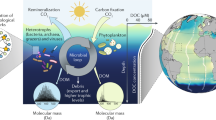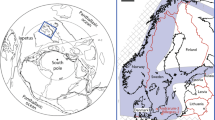Abstract
The bulk of sea water is an aqueous solution of inorganic salts and gases. However, if it was just this, life as we know it would not exist. In addition to this inorganic component, at least tens of thousands of organic molecules — collectively known as dissolved organic matter — exist in picomole amounts in each litre of sea water. Dissolved organic matter is important for aquatic food webs and, integrated over the entire volume of the world's oceans, contains roughly as much carbon as all living biota on land and in the ocean combined. Yet, the cycling of dissolved organic matter in the ocean is not well understood. Recent progress in analytical chemistry has allowed the characterization of dissolved organic matter at the molecular level in unprecedented detail, revealing that a significant proportion has been thermally altered, either in deep sediments or through combustion on land with later delivery to the sea. Thermal alteration may explain, at least in part, the resistance of oceanic dissolved organic matter to microbial decomposition.
This is a preview of subscription content, access via your institution
Access options
Subscribe to this journal
Receive 12 print issues and online access
$259.00 per year
only $21.58 per issue
Buy this article
- Purchase on Springer Link
- Instant access to full article PDF
Prices may be subject to local taxes which are calculated during checkout



Similar content being viewed by others
References
Pomeroy, L. R. Oceans food web, a changing paradigm. Bioscience 24, 499–504 (1974).
Moore, B., Edie, E. S., Whitley, E. & Dakin, W. J. The nutrition and metabolism of marine animals in relationship to (a) dissolved organic matter and (b) particulate organic matter of seawater. Biochem. J. 6, 255–296 (1912).
Kirchman, D. L., Suzuki, Y., Garside, C. & Ducklow, H. W. High turnover rates of dissolved organic-carbon during a spring phytoplankton bloom. Nature 352, 612–614 (1991).
Cherrier, J., Bauer, J. E. & Druffel, E. R. M. Utilization and turnover of labile dissolved organic matter by bacterial heterotrophs in eastern North Pacific surface waters. Mar. Ecol. Prog. Ser. 139, 267–279 (1996).
Bauer, J. E., Williams, P. M. & Druffel, E. R. M. 14C activity of dissolved organic carbon fractions in the central North Pacific and Sargasso Sea. Nature 357, 667–670 (1992).
Druffel, E. R. M., Williams, P. M., Bauer, J. E. & Ertel, J. R. Cycling of dissolved and particulate organic matter in the open ocean. J. Geophys. Res. 97, 15639–15659 (1992).
Hedges, J. I. Global biogeochemical cycles: Progress and problems. Mar. Chem. 39, 67–93 (1992).
Hansell, D. A. & Carlson, C. A. Deep-ocean gradients in the concentration of dissolved organic carbon. Nature 395, 263–266 (1998).
Hansell, D. A. & Carlson, C. A. Biogeochemistry of Marine Dissolved Organic Matter (Academic Press, 2002).
Ogawa, H., Amagai, Y., Koike, I., Kaiser, K. & Benner, R. Production of refractory dissolved organic matter by bacteria. Science 292, 917–920 (2001).
Loh, A. N., Bauer, J. E. & Druffel, E. R. M. Variable ageing and storage of dissolved organic components in the open ocean. Nature 430, 877–881 (2004).
Dittmar, T. & Koch, B. P. Thermogenic organic matter dissolved in the abyssal ocean. Mar. Chem. 102, 208–217 (2006).
Yamashita, Y. & Tanoue, E. Production of bio-refractory fluorescent dissolved organic matter in the ocean interior. Nature Geosci. 1, 579–582 (2008).
IPCC Climate Change 2007: The Physical Science Basis (eds Solomon, S. et al.) (Cambridge Univ. Press, 2007).
Peltier, W. R., Liu, Y. & Crowleay, J. W. Snowball Earth prevention by dissolved organic carbon remineralization. Nature 450, 813–819 (2007).
Ogawa, H. & Tanoue, E. Dissolved organic matter in oceanic waters. J. Oceanogr. 59, 129–147 (2003).
Dittmar, T. & Kattner G. Recalcitrant dissolved organic matter in the ocean: Major contribution of small amphiphilics. Mar. Chem. 82, 115–123 (2003).
Meyers-Schulte, K. J. & Hedges, J. I. Molecular evidence for a terrestrial component of organic matter dissolved in ocean water. Nature 321, 61−63 (1986).
Opsahl, S. & Benner, R. Distribution and cycling of terrigenous dissolved organic matter in the ocean. Nature 396, 480–482 (1997).
Keys, A., Christensen, E. H. & Krogh, A. The organic metabolism of sea water with special reference to the ultimate food cycle in the sea. Mar. Biol. Assoc. UK 20, 181–196 (1935).
Kaiser, K. & Benner, R. Biochemical composition and size distribution of organic matter at the Pacific and Atlantic Time-Series Stations. Mar. Chem. 10.1016/j.marchem.2008.12.004 (in the press).
Koch, B. P., Ludwichowski, K.-U., Kattner, G., Dittmar, T. & Witt, M. Advanced characterization of marine dissolved organic matter by combining reversed-phase liquid chromatography and FT-ICR-MS. Mar. Chem. 111, 233–241 (2008).
Mopper, K., Stubbins, A., Ritchie, J. D., Bialk, H. M. & Hatcher, P. G. Advanced instrumental approaches for characterization of marine dissolved organic matter: Extraction techniques, mass spectrometry, and nuclear magnetic resonance spectroscopy. Chem. Rev. 107, 419–442 (2007).
Reemtsma, T., These, A., Springer, A. & Linscheid, M. Differences in the molecular composition of fulvic acid size fractions detected by size-exclusion chromatography-on line Fourier transform ion cyclotron resonance (FTICR-) mass spectrometry. Water Res. 42, 63–72 (2008).
Stenson, A. C. Reversed-phase chromatography fractionation tailored to mass spectral characterization of humic substances. Environ. Sci. Technol. 42, 2060–2065 (2008).
Seitzinger, S. P. et al. Molecular-level chemical characterization and bioavailability of dissolved organic matter in stream water using electrospray-ionization mass spectrometry. Limnol. Oceanogr. 50, 1–12 (2005).
Dittmar, T., Whitehead, K., Minor, L. & Koch, B. P. Tracing terrigenous dissolved organic matter and its photochemical decay in the ocean by using liquid chromatography / mass spectrometry. Mar. Chem. 107, 378–387 (2007).
Koch, B. P., Witt, M., Engbrodt, R., Dittmar, T. & Kattner, G. Molecular formulae of marine and terrigenous dissolved organic matter detected by electrospray ionisation Fourier transform ion cyclotron resonance mass spectrometry. Geochim. Cosmochim. Acta 69, 3299–3308 (2005).
Hertkorn, N. et al. Characterization of a major refractory component of marine dissolved organic matter. Geochim. Cosmochim. Acta 70, 2990–3010 (2006).
Stenson, A. C., Marshall, A. G. & Cooper, W. T. Exact masses and chemical formulae of individual Suwannee River fulvic acids from ultrahigh resolution electrospray ionization Fourier transform ion cyclotron resonance mass spectra. Anal. Chem. 75, 1275–1284 (2003).
Koch, B. P. & Dittmar, T. From mass to structure: An aromaticity index for high-resolution mass data of natural organic matter. Rapid Commun. Mass Spectrom. 20, 926–932 (2006).
Kim, S., Simpson, A. J., Kujawinski, E. B., Freitas, M. A. & Hatcher, P. G. High resolution electrospray ionization mass spectrometry and 2D solution NMR for the analysis of DOM extracted by C-18 solid phase disk. Org. Geochem. 34, 1325–1335 (2003).
Ruiz-Morales, Y. & Mullins, O. C. Polycyclic aromatic hydrocarbons of asphaltenes analyzed by molecular orbital calculations with optical spectroscopy. Energ. Fuel. 21, 256–265 (2007).
Czimczik, C. I. & Masiello, C. A. Controls on black carbon storage in soils. Global Biogeochem. Cycles 21, GB3005 (2007).
Masiello, C. A. & Druffel, E. R. M. Black carbon in deep-sea sediments. Nature 280, 1911–1913 (1998).
Druffel, E. R. M. Comments on the importance of black carbon in the global carbon cycle. Mar. Chem. 92, 197–200 (2004).
Mannino, A. & Harvey, H. R. Black carbon in estuarine and coastal ocean dissolved organic matter. Limnol. Oceanogr. 49, 735–740 (2004).
Kim, S., Kaplan, L. A., Benner, R. & Hatcher, P. G. Hydrogen-deficient molecules in natural riverine water samples: Evidence for the existence of black carbon in DOM. Mar. Chem. 92, 225–234 (2004).
Dittmar, T., Koch, B. P., Hertkorn, N. & Kattner, G. A simple and efficient method for the solid-phase extraction of dissolved organic matter (SPE-DOM) from seawater. Limnol. Oceanogr. Methods 6, 230–235 (2008).
Dittmar, T. The molecular level determination of black carbon in marine dissolved organic matter. Org. Geochem. 39, 396–407 (2008).
CLIVAR Carbon Hydrography Data Office <http://whpo.ucsd.edu/groups?id=i06>.
Nizzetto, L. et al. PAHs in air and seawater along a North–South Atlantic transect: Trends, processes and possible sources. Environ. Sci. Technol. 42, 1580–1585 (2008).
Broecker, W. A., Sutherland, S. & Peng, T.-H. A possible 20th-century slowdown of Southern Ocean deep water formation. Science 286, 1132–1135 (1999).
Mullins, O. C., Sheu, E. Y., Hammami, A. & Marshall, A. G. Asphaltenes, Heavy Oils, and Petroleomics (Springer, 2007).
Amon, R. M. W., Fitznar, H. P. & Benner, R. Linkages among the bioreactivity, chemical composition, and diagenetic state of marine dissolved organic matter. Limnol. Oceanogr. 46, 287–297 (2001).
Acknowledgements
We thank the crew and colleagues of RV Roger Revelle for their support at sea, and K. Speer and O. Mullins for beneficial discussions. This work was financially supported by the National Oceanic and Atmospheric Administration (NOAA grant GC 05-099) and the US CLIVAR (Climate Variability and Predictability) programme.
Author information
Authors and Affiliations
Corresponding authors
Rights and permissions
About this article
Cite this article
Dittmar, T., Paeng, J. A heat-induced molecular signature in marine dissolved organic matter. Nature Geosci 2, 175–179 (2009). https://doi.org/10.1038/ngeo440
Published:
Issue Date:
DOI: https://doi.org/10.1038/ngeo440
This article is cited by
-
Rivers and tidal flats as sources of dissolved organic matter and trace metals in the German Bight (North Sea)
Biogeochemistry (2024)
-
Sources and dynamics of dissolved black carbon in the Pearl River Estuary and Shelf, Northern South China Sea
Journal of Oceanography (2024)
-
Evidence from molecular marker and FT-ICR-MS analyses for the source and transport of dissolved black carbon under variable water discharge of a subtropical Estuary
Biogeochemistry (2023)
-
Microbial degradation of various types of dissolved organic matter in aquatic ecosystems and its influencing factors
Science China Earth Sciences (2023)
-
NMR spectroscopy of dissolved organic matter: a review
Environmental Chemistry Letters (2023)



